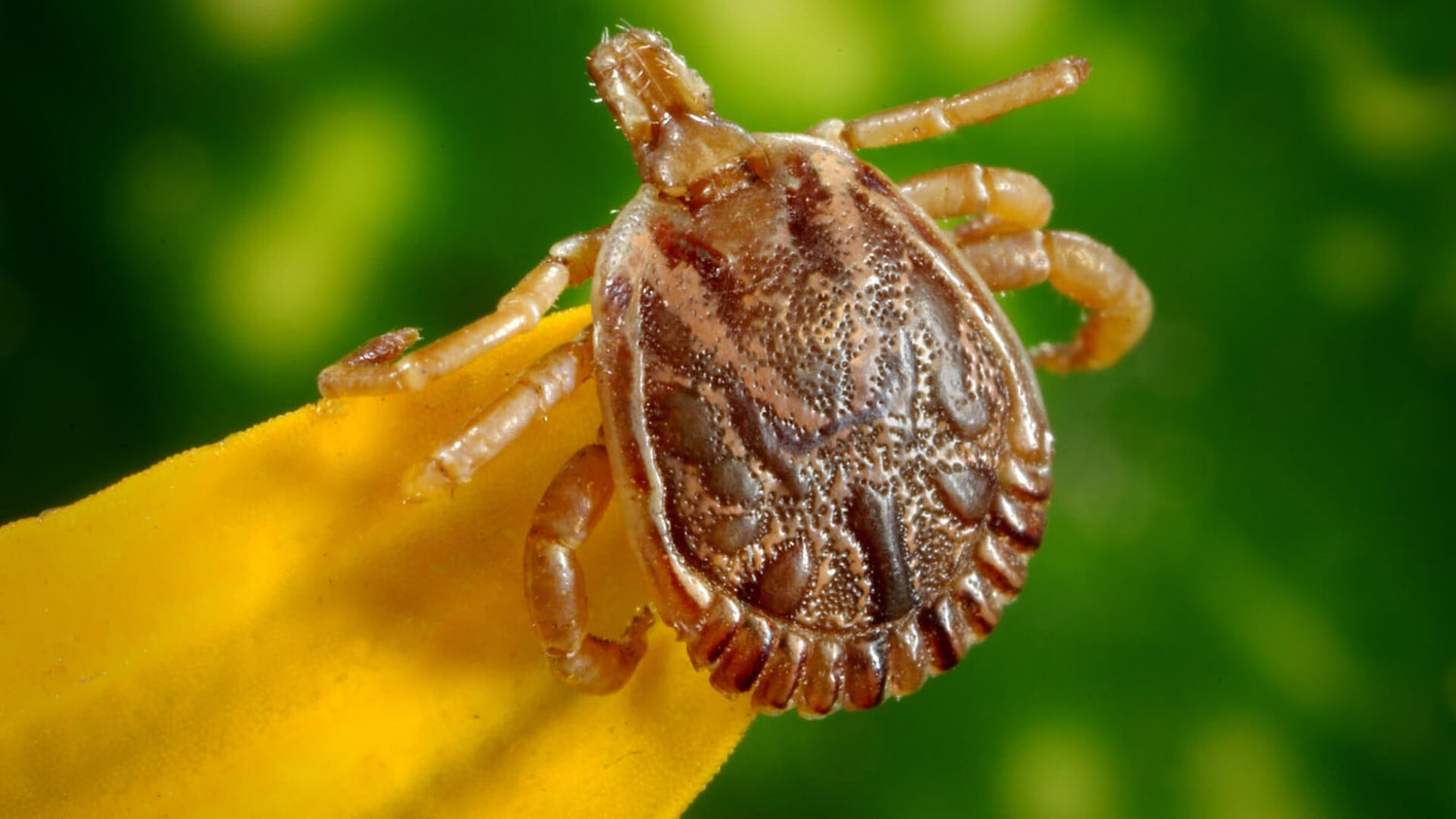Ticks are prevalent during the months of March all the way into October in tall grasses, under trees, in brush and bushes. A tick bite is not only uncomfortable for you and your dog but is also extremely dangerous, bearing numerous risks. Many dogs get infected with disease carrying pathogens. Veterinarian Philipp Schledorn explains in this interview, what types of pathogens we are talking about and why tick bites are so dangerous.

AniForte: When a tick attacks, most people talk about a tick bite. So, do ticks actually bite?
Veterinarian:
Not entirely. We do talk about tick “bites”, but in fact the tick actually “stings” us. Ticks do not bite. Instead, they bore their mouth piece into the skin of the dog or human and they will then suck blood. In young puppies or cats, this can eventually lead to anaemia, if the infestation is extreme. However, thankfully this doesn’t happen very often.
AniForte: Why are tick bites so dangerous?
Veterinarian:
When the tick bites, it will transmit certain disease carrying pathogens into the blood stream of the host. The infected dog does not necessarily have to show any symptoms right away, but from this moment on (the bite), the animal will carry these bacteria around with them and a possible infection can easily break out at a later stage. Unfortunately, many of these transmitted diseases are potentially dangerous for animals and humans.
AniForte: Which is the most common infectious disease in dogs that can be transmitted by a tick bite?
Veterinarian:
With around 80.000 diagnosed animals every year, Lyme disease, also known as borreliosis, poses the highest risk of infection. The saliva of the tick contains borreliosis bacteria and these are transmitted to the dog during the bite. Lyme disease can be extremely dangerous, if the symptoms, which are never immediately apparent, are not recognized early enough.
AniForte: What kinds of symptoms for Lyme disease do I have to look out for in my dog?
Veterinarian:
Usually, the dog will show symptoms such as fever, loss in appetite, swollen lymph nodes and even temporary paralysis. Typically for borreliosis, these symptoms will disappear after a while. However, they will then flare up again from time and time. This means that the dog will show these symptoms every now and then, seeming tired and listless. If your dog repeatedly shows these symptoms of having lost his drive or if he is even suffering from partial paralysis, it is absolutely essential to bring him to your vet. A gradual build-up in your pet can complicate the treatment of this disease.
AniForte: Is it possible to cure a dog from Lyme disease?
Veterinarian:
Yes, usually the chances of curing the disease are very good with a course of antibiotics. However, this disease has to be diagnosed correctly by using an antibody evaluation conducted by your vet. The dog may even suffer kidney failure in the most severe cases of borreliosis if this antibody count turns out to be extremely high. Also, this pathogen can also be transmitted to humans with very high risks. Every year, around a thousand cases in Europe are reported with similar symptoms.
AniForte: Which other infectious diseases can be transmitted to dogs by a tick bite?
Veterinarian:
The so-called canine malaria, babesiosis, can also be transmitted by a tick bite. The symptoms are similar to those of Lyme disease. However, additionally the dog may show signs of neurological deficits. Infected dogs may also suffer from anaemia, because their red blood cells are being destroyed by the single-cell organisms. The babesia, which are the cause for canine malaria, can be diagnosed with a blood test. For the treatment the vet will most likely prescribe antiprotozoal, which will fight the single-cell parasite. With the right treatment, the prognosis is here also very good.
AniForte: If my dog shows bleeding in addition to not eating, apathy and fever, what kind of illness is that?
Veterinarian:
This sounds very much like anaplasmosis, which is a disease caused by the bacteria Anaplasma phagocytohilum. In this case, the white blood cells in your dog are being attacked and destroyed. In Germany, around one in twenty ticks may be infected with this pathogen. With a timely diagnosis, the treatment will be a course of antibiotics and sometimes even a blood transfusion.
AniForte: What about the in early summer appearing tick-borne encephalitis (TBE). Is this viral disease also dangerous for dogs?
Veterinarian:
The TBE virus is actually targeting humans. Dogs seem to be rather resistant to this type of infection, however some isolated cases may occur. The course of this disease is rather complicated and once the host is infected, they will experience fever, apathy and aggression in addition to a possible inflammation of the brain (meningoencephalitis). This may lead to seizures, paralysis of the limbs, strabismus, narrowed pupils (miosis) and an increased perception of pain in the head and neck area. In these cases, it is all the more important to pay attention to tick bites, if you are living or walk your dog in areas, where ticks are prevalent. They often hide on trees, tall grasses, bushes and brush, or undergrowth.
AniForte: Back to today’s topic: How do you recognize tick fever in dogs?
Veterinarian:
Tick fever, otherwise known as canine granulocytic ehrlichiosis, is an acute or chronic infectious disease. The symptoms in dogs are mostly apathy, reduced appetite, which might even result in weight loss, fever, swelling of the spleen and lymph nodes, nose bleeds, bleeding of the eyes, small dotted haemorrhages in the skin, blood in the urine, stiffness in walking, oedema and swelling in the joints and limbs. Often, the dog will also simultaneously be infected with babesia, canine malaria. The so-called tick fever mostly appears in the tropic and subtropic regions as well as the Mediterranean. Hence the reason, why our dogs are most likely to get infected during vacations in these areas. These parasites can also be successfully treated with antibiotics.
AniForte: What do you recommend dog owners – especially during the spring – to avoid infections?
Veterinarian:
No responsible and caring dog or pet owner likes to see their animal suffer. However, during the spring months it is almost impossible to completely avoid contact with ticks. I definitely do recommend tick prophylaxis. This includes the obvious application of tick prevention products, but also the constant checking and monitoring of your dog after every walk. It would be best to brush your dog’s fur after every walk with a flea comb, which will brush out some of the ticks. These days, there are also certain vaccinations against borreliosis available, which would be recommended for those living in regions with extremely high tick infestations.

AniForte: And as the final question: How do you remove a tick from a dog?
Veterinarian:
Once you get the hang of it, it is actually quite easy. To remove the tick, use some water or a disinfectant solution, apply to the fur surrounding the tick and spread apart the hair in this area, so you can clearly see the tick. Using special Tick Tweezers, make sure that you get hold of the tick as close to the skin as possible to ensure that you take out the head as well and not leave any body parts of the tick in your dog’s skin, as they could get infected. Slowly, twist the tick out like a screw – the direction in which you turn is irrelevant. It is most important to inspect the initial bite site over the next few days regularly. Unfortunately, once the tick has attached itself to the host, this initial bite is sufficient to transmit any possible diseases. Hence the reason, why you should keep a close eye on your pet after being bit by a tick to watch out for sudden symptoms.
AniForte: Thank you so much for this interview.
Veterinarian: Thank you very much for the invitation. I wish all dogs and their owners a tick-free summer!






